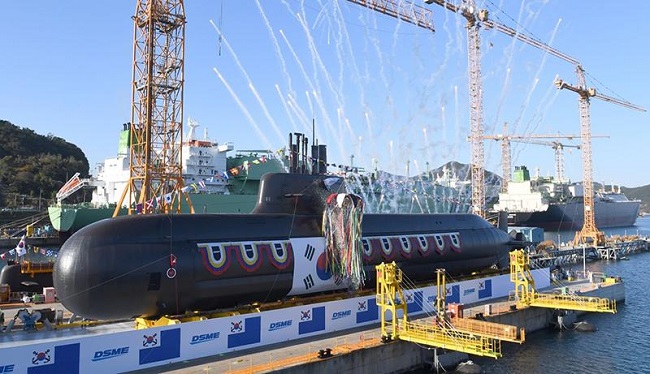
This file photo, taken Nov. 10, 2020, shows South Korea’s new 3,000-ton indigenous submarine, the Ahn Mu, being anchored at the Okpo Shipyard of Daewoo Shipbuilding and Marine Engineering Co. in the southeastern city of Geoje. (Yonhap)
SEOUL, April 20 (Korea Bizwire) — South Korea’s Navy on Thursday received a new 3,000-ton submarine with reinforced capabilities to conduct covert underwater missions and precision strikes, the state arms procurement agency said.
The delivery ceremony for the ROKS Ahn Mu, named after a renowned Korean independence fighter, took place at the Okpo Shipyard of Daewoo Shipbuilding and Marine Engineering Co. in Geoje, 331 kilometers southeast of Seoul, according to the Defense Acquisition Program Administration (DAPA).
The new submarine is the second vessel built under the Changbogo-III Batch-I program designed to produce three 3,000-ton, 83-meter-long submarines capable of carrying 50 crewmembers.
Its launch ceremony was held in November 2020.
It is equipped with vertical launching tubes for submarine-launched ballistic missiles that would enable the vessel to carry out precision strikes at key ground targets in a “strategic” contingency mission, according to DAPA.
DAPA cast the ROKS Ahn Mu as a “core” asset of the South’s Kill Chain preemptive strike system, a pillar of its three-pronged defense architecture that includes the Korea Massive Punishment and Retaliation, an operational plan to incapacitate the North Korean leadership in a conflict, and the Korea Air and Missile Defense system.
The submarine also features the latest vibration and noise reduction technologies, as well as an advanced combat and sonar system, according to DAPA. Parts made by Korean businesses accounted for 76 percent of the total.
It is set to go into service next year following around eight months of operational tests.
(Yonhap)






